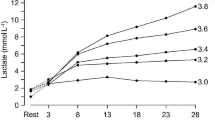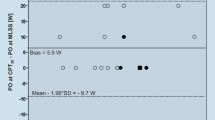Abstract
Criteria for the identification of maximal steady state as related to state of conditioning were evaluated. 13 volunteers walked and/or ran during a series of 15 min tests on a treadmill. The speeds ranged from mild to exhaustive. Heart rate was monitored continuously;\(\dot V_{O_2 } \) was determined from 6 min to 9 min; and venous blood was obtained at 10 min and 15 min for lactate analyses. Max\(\dot V_{O_2 } \) was established for each subject. Subjects were classified on level of conditioning according to the quantity and quality of their activity record for the previous 6 months. The 10 min heart rate associated with a blood lactate level of 2.2 mM/L (MSSHR) was the best predictor of conditioning. The relative\(\dot V_{O_2 } \) (% of max\(\dot V_{O_2 } \)) found with a 10 min blood lactate concentration of 2.2 mM/L (RMSS\(\dot V_{O_2 } \)) was almost as accurate as MSSHR in predicting state of conditioning. Changes in blood lactate levels between 10 min and 15 min were not significantly related to conditioning.
Similar content being viewed by others
References
Åstrand, P. O., Rodahl, K.: Textbook of work physiology. New York: McGraw-Hill 1970
Åstrand, P. O., Saltin, B.: Oxygen uptake during the first minutes of heavy muscular exercise. J. appl. Physiol.16, 971–976 (1961)
Bang, O.: The lactate content of the blood during and after muscular exercise in man. Skand. Arch. Physiol.74 (Suppl. 10) (1936)
Consolazio, D. J., Johnson, R. E., Pecora, L. J.: Physiological measurements of metabolic functions in man. New York: McGraw-Hill 1963
Costill, D. L.: What research tells the coach about distance running. Washington, D.C.: AAHPER 1968
Costill, D. L., Branam, G., Eddy, D., Sparks, K.: Determinants of marathon running success. Int. Z. angew. Physiol.29, 249–254 (1971)
Ekblom, B.: Effect of physical training on oxygen transport system in man. Acta physiol. scand.77 (Suppl. 328) (1969)
Elsner, R. W., Carlson, L. D.: Postexercise hyperemia in trained and untrained subjects. J. appl. Physiol.17, 436–440 (1962)
Gledhill, N.: The effect of various training intensities on cardiorespiratory fitness. Unpublished master's thesis, University of Western Ontario (1968)
Gollnick, P. O., Ianuzzo, C. D., King, D. W.: Ultrastructure and enzyme changes in muscles with exercise. In: Muscle metabolism during exercise, B. Pernow, B. Saltin, eds., pp. 69–85. New York: Plenum Press 1971
Hermansen, L., Hultman, E., Saltin, B.: Muscle glycogen during prolonged severe exercise. Acta physiol. scand.71, 129–139 (1967)
Hermansen, L., Saltin, B.: Blood lactate concentration during exercise at acute exposure to altitude. In: Exercise at altitude, R. Margaria, ed., pp. 48–53. Amsterdam: Excerpta Medica Foundation 1967
Holloszy, J. O.: Biochemical adaptations in muscle: Effects of exercise on mitochondrial oxygen uptake and respiratory enzyme activity in skeletal muscle. J. biol. Chem.242, 2278–2282 (1967)
Holloszy, J. O., Oscai, L. B., Molé, P. A., Don, I. J.: Biochemical adaptations to endurance exercise in skeletal muscle. In: Muscle metabolism during exercise, B. Pernow, B. Saltin, eds., pp. 51–61. New York: Plenum Press 1971
Karlsson, J., Nordesjo, L. O., Jorfeldt, L., Saltin, B.: Muscle lactate, ATP and CP levels during exercise after physical training in man. J. appl. Physiol.33, 199–208 (1972)
Klissouras, V.: Genetic limit of functional adaptability. Int. Z. angew. Physiol.30, 85–94 (1972)
Marbach, E. P., Weil, M. H.: Rapid enzymatic measurements of blood lactate and pyruvate. Clin. Chem.13, 314–325 (1967)
Molé, P. A., Holloszy, J. O.: Exercise-induced increase in the capacity of skeletal muscle to oxidize palmitate. Proc. Soc. exp. Biol. (N.Y.)134, 789–792 (1970)
Petren, T., Sjostrant, T., Sylven, B.: Der Einfluß des Trainings auf die Häufigkeit der Capillaren in Herz- und Skelettmuskulatur. Arbeitsphysiologie9, 376–386 (1936)
Rohter, F. D., Rochelle, R. H., Human, D.: Exercise blood flow changes in the human forearm during physical training. J. appl. Physiol.18, 789–793 (1963)
Saiki, H., Margaria, R., Currica, F.: Lactic acid production in submaximal muscular exercise. In: Exercise at altitude, R. Margaria, ed., pp. 54–57. Amsterdam: Excerpta Medica Foundation 1967
Saltin, B.: Guidelines for physical training. Scand. J. Rehab. Med.3, 39–46 (1971)
Saltin, B., Blomqvist, G., Mitchell, J. H., Johnson, R. L., Jr., Wildenthal, K., Chapman, C. B.: Response to exercise after bed rest and after training. Circulation38 (Suppl. VII) (1968)
Wert, J. E., Neidt, C. O., Ahmann, J. S.: Statistical methods in educational and psychological research. New York: Appleton-Century-Crofts 1954
Whipple, G. H.: The hemoglobin of striated muscle: 1. Variations due to age and exercise. Amer. J. Physiol.76, 693–707 (1962)
Williams, C. G., Wyndham, C. H., Kok, R., von Rahden, M. J. E.: Effect on training on maximal oxygen intake and on anaerobic metabolism in man. Int. Z. angew. Physiol.24, 18–23 (1967)
Wyndham, C. H., Seftel, H. C., Williams, C. G., Wilson, V., Strydom, N. B., Bredell, G. A. G., von Rahden, M. J. E.: Circulatory mechanism of anaerobic metabolism in working muscle. S. Afr. med. J.39, 1008–1014 (1965)
Author information
Authors and Affiliations
Rights and permissions
About this article
Cite this article
Londeree, B.R., Ames, S.A. Maximal steady state versus state of conditioning. Europ. J. Appl. Physiol. 34, 269–278 (1975). https://doi.org/10.1007/BF00999940
Received:
Issue Date:
DOI: https://doi.org/10.1007/BF00999940




